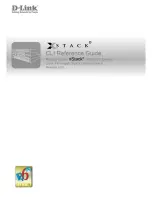
This command has the following limitations:
•
The display output is sorted by prefixes; intra-area ECMP routes are not displayed together.
•
For Type 2 external routes, Type 1 cost is not displayed.
NOTE:
Starting with Version 9.4(0.0), the loopback IP address advertised to the neighbor is not
displayed in the output because they are not accounted as inactive OSPF routes, whereas the loopback
IP address is displayed until Dell Networking OS Version 9.3(0.0). Starting with Version 9.4(0.0), the
show ip ospf routes command displays the interface and area ID information of connected networks in
addition to the other settings, whereas these details are not displayed until Dell Networking OS Version
9.3(0.0). Starting with Version 9.4(0.0), the metric of E2 routes in the output is displayed as an external
metric, whereas until Dell Networking OS Version 9.3(0.0), the number of hops to the ASBR for E2
routes are displayed in the output.
Example
Dell# show ip ospf 100 route
Prefix Cost Nexthop Interface Area Type
1.1.1.1 1 0.0.0.0 Lo 0 0 Intra-Area
3.3.3.3 2 13.0.0.3 Te 1/1/4/1 1 Intra-Area
13.0.0.0 1 0.0.0.0 Te 1/1/4/1 0 Intra-Area
150.150.150.0 2 13.0.0.3 Te 1/1/4/1 - External
172.30.1.0 2 13.0.0.3 Te 1/1/4/1 1 Intra-Area
Dell#
show ip ospf statistics
Display OSPF statistics.
Syntax
show ip ospf [
process-id
| vrf
vrf-name
] statistics global | [interface
name
{neighbor
router-id
}]
Parameters
process-id
Enter the OSPF Process ID to show a specific process. If no Process ID is entered,
command applies only to the first OSPF process.
vrf
vrf-name
Enter the keyword
vrf
followed by the name of the VRF to display statistics
corresponding to the OSPF process that is tied to a specific VRF.
global
Enter the keyword
global
to display the packet counts received on all running OSPF
interfaces and packet counts OSPF neighbors receive and transmit.
interface
name
(OPTIONAL) Enter the keyword
interface
then one of the following interface
keywords and slot/port or number information:
•
For a 10-Gigabit Ethernet interface, enter the keyword
TenGigabitEthernet
then
the stack/slot/port/subport information.
•
For a 25-Gigabit Ethernet interface, enter the keyword
twentyFiveGigE
then the
stack/slot/port/subport information.
•
For a 40-Gigabit Ethernet interface, enter the keyword
fortyGigE
then the stack/
slot/port[/subport] information.
•
For a 50-Gigabit Ethernet interface, enter the keyword
fiftyGigE
then the stack/
slot/port/subport information.
•
For a 100-Gigabit Ethernet interface, enter the keyword
hundredGigE
then the
stack/slot/port information.
1138
Open Shortest Path First (OSPFv2 and OSPFv3)
Содержание S6100
Страница 1: ...Dell Command Line Reference Guide for the S6100 ON System 9 11 2 0P1 ...
Страница 474: ...protocol list ttl0 ttl1 Dell 474 Control Plane Policing CoPP ...
Страница 979: ... show lldp neighbors display the LLDP neighbors Link Layer Discovery Protocol LLDP 979 ...
Страница 1627: ... uplink state group creates an uplink state group and enables the tracking of upstream links Uplink Failure Detection UFD 1627 ...
















































